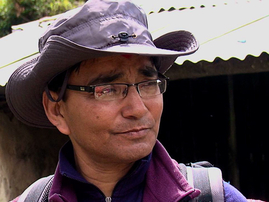 Anil Parajuli 2012
Anil Parajuli 2012 During my six-week assignment in Nepal, I spent a lot of time with the co-founder of Himalayan HealthCare, Anil Parajuli. One thing is unmistakable. The people of Nepal love this man. Not that I have ever walked the streets with Bono (let alone met him), walking through the streets of Kathmandu and rural villages with Anil was pretty close to it. People of all walks of life wave and call out his name. When I mention my observation, he laughs it off and tells me I am overly dramatic. “No one is that important here,” he says. I beg to differ. He has been named an Ashoka Fellow, recognized as one of the top fifty personalities in Nepal four times and has received numerous awards and has been offered fellowships at Harvard for his efforts.
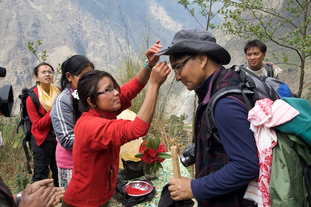 Anil Parajuli greeted by villagers in Tipling Nepal
Anil Parajuli greeted by villagers in Tipling Nepal The unassuming humanitarian is the first to tell you his life’s work is the result of the most traumatic event of his life. “Simply put” Anil says, ” I was kicked out of medical school a little over twenty years ago and when you are the son of a highly regarded physician and humanitarian, there is not much worse you can do when your only responsibility is to graduate.”
He can talk about it now without anger, but I sense a tad of irritation in his voice as he describes what led to his ouster from the prestigious Armed Forces Medical College in Pune India. “All I had to do is graduate. That is it!” I was six months out” Anil recalls. A series of innocent circumstances lead school authorities to determine he was a bit too much of a rebel for their taste. “The student sit-in” he says “was the last straw.”
As I listen to his story, it is clear his “failure” as he calls it, was the inability to say no to help people in need, something he struggles with to this day. He put the needs of others before his studies and paid the consequences. Anil has difficulty expressing the complex feelings he had at the time of his ejection, but admits he fell into a deep depression.
To cope, Anil pursued his lifelong hobby of trekking. Ultimately, he would organize and lead tours all over Nepal. It was through this family business that he realized he could bring hope to the thirteen thousand or so impoverished inhabitants of the Dhading region, which is located in central Nepal. Utilizing his medical training, he began bringing supplies and medicines into the villages and providing basic health care to the people he met during his treks.
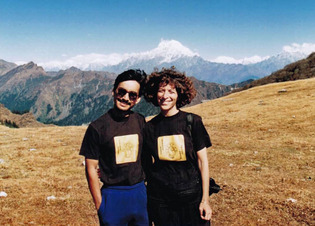 HHC co-founders Anil Parajuli and Lisa Gomer
HHC co-founders Anil Parajuli and Lisa Gomer Although the seed to his humanitarian efforts was planted during his childhood years spent at a Jesuit boarding school, he says “I could not just hike through the villages with wealthy foreigners and not help the local population. We are talking about severe malnutrition among other life threatening medical issues. Babies were dying daily”. To this day, Anil cannot bear to look a child in the eye as it triggers memories of the ones he could not save.
Eventually, his compassion drew the attention of sympathetic American lawyer and fellow trekker, Lisa Gomer, who offered to help him establish a 501 (c) 3 non-profit in 1992. The organization has a parallel board in Nepal. Its members and Anil have always made the decisions for HHC. Nearly twenty years later, surviving a devastating civil war, economic hardship and famine, Himalayan HealthCare is considered one of the most successful Nepalese humanitarian organizations in country. Of the thirty thousand or so non-governmental organizations (NGOs) in Nepal, HHC is the only one, which operates in the Dhading region. He says the mission is quite simple: Help people help themselves.
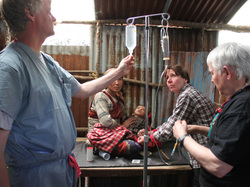 Medical volunteers treat dying child
Medical volunteers treat dying child The organization has a three-prong approach to their success: healthcare, education and income generation. The success did not come without failures. Anil says over the years, HHC implemented dozens of different programs that failed miserably. They finally began to collaborate with a number of organizations, including Gulf For Good, Jolka, Direct Relief International. These partnerships have resulted in magnificent growth and much needed social change in the villages.
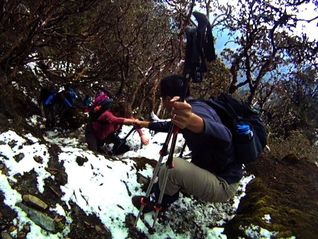 Dr. Thomas Kim assists Dr. Caroline Jones on trek
Dr. Thomas Kim assists Dr. Caroline Jones on trek Another successful program Anil is proud of is the medical camp expeditions. Having spent much of his life organizing and leading treks, you would never know the man is scared of heights. “I am a city boy and they say in Nepal there are two directions of travel; up and down. I have trouble with heights and altitude,” he admits. Several times a year he organizes and leads an international team of volunteers composed of doctors, dentist and other medical personnel to hike up to the remote mountain villages to conduct specialty medical camps. The experience is not one-sided. The Nepali health workers and community leaders work side by side with the international team in order to hone their medical skills, and the volunteers gain valuable experience in the health challenges facing developing countries. The fourteen-day expeditions, which will take team members up to fifteen thousand feet, are extreme and physically challenging to those who participate. It is no different than organizing an Everest expedition, which Parajuli has done many times.
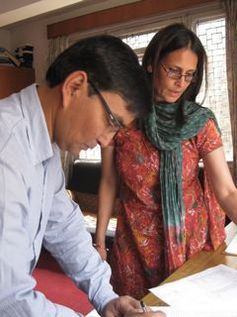 Anil and his wife Soni
Anil and his wife Soni With the help of his wife Soni, the duo works around the clock to make sure nothing is left to chance. “Just working with the Nepalese government is frustrating” Anil groans. “Getting the permits and official documents is exhausting and time consuming. Everything takes ten times the effort. You take one step forward and two step backwards.”
Soni gave up a comfortable job to help her husband run the non-profit after going on her first medical trek in 2010. She mentions there are things behind the scenes no one would ever consider. “We have to make sure the Sherpas are healthy for the trek. We will have close to one hundred Sherpas, porters and cooking staff working night and day. They have to be healthy. We also make sure we have the right foods for the volunteers.” Anil adds that he and several Sherpas thoroughly inspect every piece of equipment. “Every spoon, every light, sleeping mat, chair and tent are checked out and repaired to make sure everything is in perfect working order because there is no room on the mountain for equipment failure.”
The passion for humanitarianism is not lost on Anil and Soni. On the condition they pass their exams, their two young daughters, Sitashma, Priyasha and six year old son, Saharsha join them on the expeditions. So far they have not missed a trek.
Soni gave up a comfortable job to help her husband run the non-profit after going on her first medical trek in 2010. She mentions there are things behind the scenes no one would ever consider. “We have to make sure the Sherpas are healthy for the trek. We will have close to one hundred Sherpas, porters and cooking staff working night and day. They have to be healthy. We also make sure we have the right foods for the volunteers.” Anil adds that he and several Sherpas thoroughly inspect every piece of equipment. “Every spoon, every light, sleeping mat, chair and tent are checked out and repaired to make sure everything is in perfect working order because there is no room on the mountain for equipment failure.”
The passion for humanitarianism is not lost on Anil and Soni. On the condition they pass their exams, their two young daughters, Sitashma, Priyasha and six year old son, Saharsha join them on the expeditions. So far they have not missed a trek.
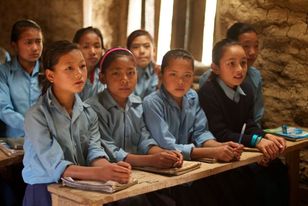 Students at village school
Students at village school Although Anil has been recognized for his work, having been declared an Ashoka Fellow and named as one of the top fifty personalities in Nepal, he feels his biggest achievement is two-fold. “When we started going up into the villages, we could not convince the families to let their children attend school,” he recalls. “All we needed was to get the ball rolling. We were able to improve the education standards in the schools and began offering scholarships for some of the children to be educated in Kathmandu. Once we did this, the people could see the benefit of education and began allowing their children to attend the local schools.” Initially, according to the HHC annual report, only a handful of students were attending school. Today, every village household has children attending school. HHC’s support does not end with primary level education. They also sponsor high school graduates to attend technical schools and colleges.
(photo courtesy of Robert Stern. copyright 2012)
(photo courtesy of Robert Stern. copyright 2012)
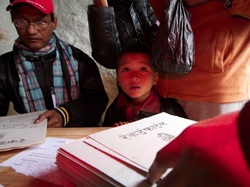 Village boy waits to be examined
Village boy waits to be examined Anil sums up his greatest achievement as hope. “We have given hope to the people of these villages. We continued to provide our services throughout the civil war,” he vividly remembers. “The Maoists were not happy we were in the villages. They were walking around with guns and grenades. They stole our medicines, threatened the villagers, my staff, me and members of my family. Members of my staff were kidnapped and I had to pay a ransom to gain their release. Nothing was going to keep us away. Like a bad rash” he laughs “We stayed on.”
(photo courtesy of Robert Stern. copyright 2012)
(photo courtesy of Robert Stern. copyright 2012)
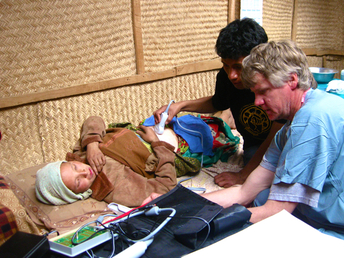 Dr. Robert McKersie teaches ultrasound to healthcare worker
Dr. Robert McKersie teaches ultrasound to healthcare worker Today, some of the same Maoists still live in the villages that HHC serves. Anil describes the current relationship with the Maoist as a level of “mutual respect”. “We have to get along with all political groups because we want to continue to bring services that otherwise, would not be available to the populations here.
Anil says the most difficult part of the job is asking for money to fund the mission. He spends months abroad holding his hat out for even the smallest donation. “With the amount of time I spend on fundraising, I could be here doing the desperately needed worked in the villages. I wish I could just win the lottery,” he says. It’s funny, I can face the Maoists, but I find it tougher to ask for money. In the end, it is not about me, the Maoists or the bureaucracy of the government. It is about the people we serve in the villages and whatever it takes to accomplish the mission.”
To learn more about Anil and Himalayan HealthCare visit http://www.himalayanhealthcare.org/
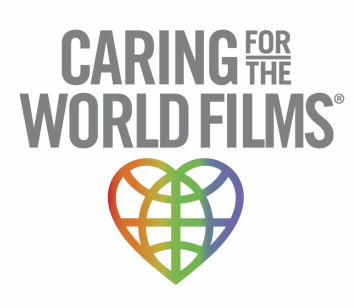
 RSS Feed
RSS Feed